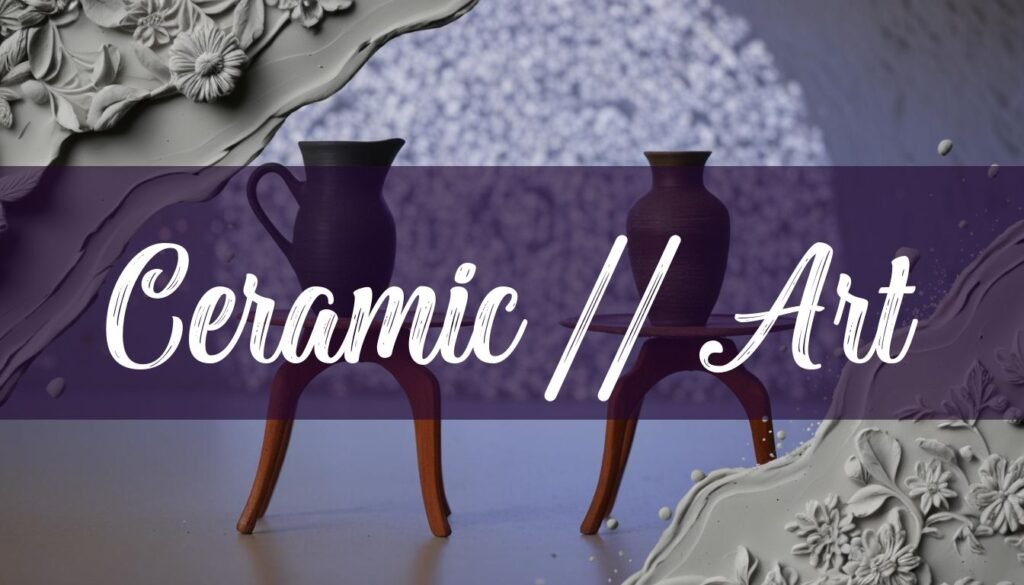Ceramic art is a captivating realm where earth transforms into enduring forms of beauty and expression. It encompasses a wide array of artistic creations, from functional pottery to intricate sculptures, all crafted from clay and hardened through firing. Ceramic art is more than just a craft; it is a sophisticated art form that combines technical skill, artistic vision, and a deep understanding of materials. It represents a continuous dialogue between the artist, the clay, and the transformative power of fire. Throughout history, ceramic art has served not only practical purposes but also as a medium for storytelling, cultural expression, and aesthetic exploration, demonstrating its timeless appeal and enduring significance.
Ceramic art distinguishes itself through its focus on artistic expression and conceptual depth, differing from functional craft, which primarily emphasizes utility. While a ceramic mug might serve the simple purpose of holding a beverage, a ceramic artwork provokes thought, evokes emotion, or challenges perceptions. The artist’s intent takes precedence, guiding the selection of materials, techniques, and forms to convey a specific message or aesthetic vision. This distinction is not always clear-cut, as functional objects can possess artistic merit and sculptural pieces can draw inspiration from utilitarian forms. What truly sets ceramic art apart is the artist’s conscious effort to transcend mere functionality and engage in a creative dialogue that pushes the boundaries of the medium.
The history of ceramic art spans millennia, with early examples serving both practical and ritualistic purposes. Ancient civilizations, such as the Egyptians, Greeks, and Chinese, developed sophisticated ceramic techniques and produced objects of remarkable beauty and durability. From the terracotta warriors of China to the intricately decorated vases of ancient Greece, ceramics have provided invaluable insights into past cultures and artistic traditions. Over time, ceramic art has evolved, influenced by technological advancements, cultural exchanges, and the individual visions of countless artists. The Arts and Crafts movement of the late 19th and early 20th centuries saw a renewed interest in handcrafted ceramics, while the mid-20th century witnessed a surge in studio pottery, with artists like Bernard Leach championing a synthesis of Eastern and Western ceramic traditions. Today, ceramic art continues to flourish, with artists pushing the boundaries of the medium in exciting and innovative ways. You can even see ceramic art installations that fuse tradition with innovation.
Techniques and Processes in Ceramic Art
Creating ceramic art involves a diverse range of techniques, each offering unique possibilities for shaping and decorating clay. Hand-building techniques, such as coiling, pinching, and slab construction, provide a direct and intimate way of working with the material. Coiling involves rolling clay into long, snake-like strands and layering them to build up forms, while pinching uses the fingers to mold and shape the clay. Slab construction involves joining flat pieces of clay to create geometric or organic forms. Wheel throwing, another fundamental technique, utilizes a rotating pottery wheel to shape symmetrical vessels with speed and precision. Slip casting, on the other hand, involves pouring liquid clay into plaster molds to create complex and uniform shapes. Each of these techniques demands skill and patience, but the rewards are the ability to produce an array of unique forms.
Once a ceramic piece has been formed, it can be decorated using a variety of surface techniques. Glazing, perhaps the most well-known decorating method, involves applying a layer of vitreous material to the surface of the clay, which then melts and fuses to the clay during firing, creating a protective and decorative coating. Glazes come in a wide range of colors and textures, allowing artists to achieve a myriad of visual effects. Other surface techniques include sgraffito, where the artist scratches through a layer of slip to reveal the clay beneath, and slip trailing, where slip is applied to the surface of the clay using a squeeze bottle or applicator to create raised designs. Underglazes, which are pigments applied to the clay before glazing, can also be used to add color and detail. The choice of surface decoration technique depends on the artist’s vision and the desired aesthetic effect. For example, you may want to use engobe for your application.
The final stage in creating ceramic art is firing, a transformative process that hardens the clay and fuses the glaze to its surface. Firing takes place in a kiln, a specialized oven capable of reaching extremely high temperatures. There are different types of kilns, including electric, gas, and wood-fired kilns, each producing unique effects on the clay and glazes. Electric kilns are the most common and offer precise temperature control, while gas kilns allow for reduction firing, where the amount of oxygen in the kiln is reduced, creating unique color and texture variations. Wood-fired kilns, which have been used for centuries, produce the most organic and unpredictable results, with the ash from the burning wood creating natural glazes on the surface of the pottery. The firing process is a delicate balance of time, temperature, and atmosphere, and the results can be both magical and unpredictable.
Styles, Forms, and Influential Artists
Ceramic art encompasses a vast array of styles and forms, reflecting the diverse visions and approaches of artists throughout history and across cultures. Functional pottery, such as bowls, vases, and teapots, remains a popular form of ceramic art, with artists exploring new ways to elevate these everyday objects to works of art. Ceramic sculpture, on the other hand, allows artists to push the boundaries of form and create purely aesthetic objects that express a wide range of ideas and emotions. From abstract geometric forms to figurative representations, ceramic sculpture can be both monumental and intimate, challenging our perceptions of space and form.
Throughout the history of ceramic art, numerous artists have made significant contributions to the field, shaping its evolution and inspiring generations of potters and sculptors. Bernard Leach, a British potter who spent many years in Japan, is considered one of the most influential figures in 20th-century studio pottery, championing a synthesis of Eastern and Western ceramic traditions. Lucie Rie, another prominent figure in British studio pottery, is known for her elegant and refined vessels, characterized by their simple forms and subtle glazes. In the realm of ceramic sculpture, Ken Price challenged the traditional perception of ceramics as craft, approaching the medium from a contemporary point of view and creating abstract shapes with vibrant colors. Contemporary ceramic artists like Grayson Perry continue to push the boundaries of the medium, using ceramic vases as a canvas for social commentary and personal narratives.
The role of ceramic art in contemporary art is constantly evolving, with artists exploring new ways to incorporate ceramics into their practice and challenging traditional notions of the medium. Ceramic art is no longer confined to the realm of craft but has become an integral part of the contemporary art world, with ceramic sculptures and installations being exhibited in major museums and galleries around the globe. Artists are experimenting with new technologies, such as 3D printing and digital modeling, to create complex and intricate ceramic forms. They are also exploring the intersection of ceramics with other media, such as video, performance, and installation art, creating immersive and multi-sensory experiences for the viewer. As ceramic art continues to evolve, it promises to remain a vital and dynamic force in the contemporary art world, challenging our perceptions of art and the world around us.





